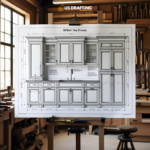In the construction and interior design industries, precision is key to ensuring seamless project execution. For contractors, millwork shop drawings serve as an essential blueprint for custom woodwork, cabinetry, and architectural elements.
These detailed drawings provide accurate measurements, materials specifications, and assembly guidelines, minimizing errors and streamlining communication between designers, fabricators, and installers.
By relying on precise millwork shop drawings, contractors can improve efficiency, reduce costly rework, and deliver high-quality craftsmanship that meets client expectations. This article explores the various ways contractors benefit from detailed and accurate millwork shop drawings.
Understanding Millwork Shop Drawings
Millwork shop drawings are detailed blueprints used in woodworking and construction. They help carpenters, designers, and builders understand how custom woodwork, such as cabinets, doors, and trim, should be made and installed. These drawings act as a guide, showing precise measurements, materials, and design details.
A good millwork drawing includes different views, such as front, top, and side perspectives, to give a clear picture of the final product. It also contains dimensions, materials, joinery methods, and finishing details. These details help ensure that the finished woodwork fits perfectly in the given space.
Millwork shop drawings are essential for communication between designers, clients, and manufacturers. They prevent errors by providing clear instructions before production begins. Without accurate drawings, mistakes can happen, leading to wasted materials, delays, and extra costs.
Creating these drawings requires skill and attention to detail. Designers use specialized software to make precise plans. Sometimes, hand-drawn sketches are also used for smaller projects. Before production starts, the drawings go through a review process where clients and architects approve them.
By understanding millwork shop drawings, builders and designers can ensure smooth project execution. These drawings make custom woodwork projects more efficient, helping everyone involved work with accuracy and confidence.
Benefits of Precise Millwork Shop Drawings for Contractors
Millwork shop drawings are detailed plans that show how custom woodwork and other elements should be built and installed. These drawings help contractors work more efficiently and avoid mistakes. Here are some key benefits of using precise millwork shop drawings:
Improved Project Planning and Coordination
With clear shop drawings, all teams involved in the project—contractors, designers, and fabricators—can stay on the same page. This improves communication and helps prevent misunderstandings that could delay the project.
Enhanced Accuracy and Reduced Errors
Accurate drawings provide exact measurements and specifications, reducing the risk of errors during construction. This means fewer costly mistakes and rework, saving both time and money.
Efficient Fabrication and Installation
When fabricators have precise shop drawings, they can create millwork components more efficiently. Contractors can also install these pieces smoothly, avoiding delays caused by ill-fitting parts or design issues.
Cost Savings and Budget Control
Precise drawings help avoid waste by ensuring the correct materials and measurements are used. This reduces unnecessary expenses and helps contractors stay within budget.
Compliance with Industry Standards and Regulations
Shop drawings ensure that all millwork elements meet industry standards and building codes. This helps contractors pass inspections smoothly and deliver a high-quality final product.
By using detailed millwork shop drawings, contractors can improve efficiency, reduce errors, and save costs, leading to successful project completion.
Role of Technology in Creating Precise Millwork Drawings
Technology has transformed the way millwork drawings are created. In the past, woodworkers and architects relied on hand-drawn plans, which took time and often led to errors. Today, advanced software and digital tools have made the process faster, more accurate, and highly detailed.
One of the biggest advancements is CAD (Computer-Aided Design) software. It allows designers to create detailed 2D and 3D drawings with exact measurements. This reduces mistakes and ensures that all parts fit perfectly during construction. With CAD, revisions are also easier, saving both time and materials.
Another helpful technology is BIM (Building Information Modeling). BIM provides a 3D model that includes every detail of the millwork project. It helps designers, manufacturers, and contractors collaborate efficiently, reducing miscommunication.
CNC (Computer Numerical Control) machines also play a major role. They use digital designs to cut, shape, and carve wood with extreme precision. This eliminates human error and speeds up production.
Additionally, laser measuring tools ensure accuracy from the start. They capture exact dimensions of a space, helping designers create millwork that fits perfectly.
Overall, technology has improved precision, efficiency, and collaboration in millwork design. It ensures high-quality results while reducing waste and errors. As technology continues to advance, millwork will become even more refined and efficient.
Conclusion
Precise millwork shop drawings play a crucial role in ensuring efficiency, accuracy, and cost-effectiveness in construction and woodworking projects. By providing detailed blueprints with exact measurements and specifications, these drawings help contractors streamline fabrication and installation, reducing errors and minimizing waste. Improved communication and coordination between designers, fabricators, and installers lead to smoother project execution and higher-quality craftsmanship.
With advancements in technology, tools like CAD, BIM, CNC machines, and laser measuring devices have further enhanced the precision and efficiency of millwork drawings. These innovations not only reduce human error but also optimize production, ensuring that each custom element fits seamlessly into its designated space.
For contractors, investing in precise millwork shop drawings means fewer delays, better compliance with industry standards, and greater client satisfaction. By embracing these detailed plans and leveraging modern technology, they can successfully complete projects with accuracy, efficiency, and excellence.

